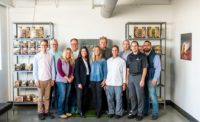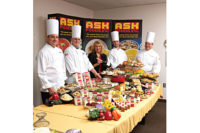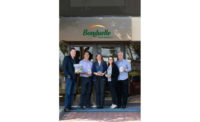Refrigerated Processor of the Year: Change on a Dime
ASK Foods excels in manufacturing ready-to-market products thanks to its ability to be quick, flexible and current with today’s trends.

Pasta is hoisted from the cooking system into the cooling unit. Photo by Vicki Simpson, www.simoneassociates.com

An automated pre-pack line fills 60 containers a minute, complete with a wrap-around label, and can fill everything from an 8-ounce to 3-pound containers. Photo by Vicki Simpson, www.simoneassociates.com

Seven different kettles, holding up to 1,000 pounds of pasta each, add flexibility to the line. Photo by Vicki Simpson, www.simoneassociates.com

In the formulation and packaging line, larger-sized spiral pasta salad is manually filled to maintain quality and appearance. Photo by Vicki Simpson, www.simoneassociates.com

Two rotary oven systems are designed to bake high-end entrées. At the time of Refrigerated & Frozen Foods’ visit, ASK Foods was baking lasagna. Photo by Vicki Simpson, www.simoneassociates.com

The bake-in-box trays offer the ultimate protection in food safety, as there is no interference with human hands. Photo by Vicki Simpson, www.simoneassociates.com

Most finished product ships from seven docks within a 24- to 30-hour timeframe. Photo by Vicki Simpson, www.simoneassociates.com

ASK Foods conducts real shelf-life testing. Here, Mark Doyle, quality assurance supervisor, tests for aerobic plate count, yeast/mold and coliforms. Photo by Vicki Simpson, www.simoneassociates.com








In this article, you'll learn ...
-
All about ASK Foods, RFF's 2013 Refrigerated Foods Processor of the Year
-
ASK Foods' processes and their methods of shelf-testing
Whatever the customer wants, the customer gets. Sounds too easy, right? But, for the folks at ASK Foods, Inc., being quick and flexible is simply part of the job.
“We don’t want employees who just stand there and push a button in a factory,” says Wendie DiMatteo Holsinger, chief executive officer. “If you’ve ever watched a race where the NASCAR pit crew come in for a few seconds, change the wheels, do the other things they need to do and get the car out. That’s the kind of person we want. Someone who is quick thinking and likes change.”
It’s that drive for change that keeps ASK Foods at the forefront of today’s ever-changing trends.
Whether it’s working with new packaging, updating production lines or learning a new recipe, the Palmyra, Pa.-based company can change on a dime. That’s why this privately-held, SQF-certified company was named Refrigerated & Frozen Foods’ 2013 Refrigerated Foods Processor of the Year.
This year, the 100% woman-owned company celebrates its 65th anniversary with an 8,000-square-foot addition to its already 75,000-square-foot plant. Scheduled to debut March 15, the construction includes space for additional kettles and blanchers, as well as a state-of-the-art retort with a vacuum cooling system.
“We only have a few designated specialty lines,” says Jerry Crawford, director of operations. “Every day, we move quickly through a wide range of recipes, changing products rapidly. We’re doing 120 recipes a day, basically 60 per shift, so that’s a lot of changeover, and everything has to click to make it work.”
Firing on all cylinders
At the time of Refrigerated & Frozen Foods’ visit, ASK Foods was producing several lines of side dishes featuring potatoes, pasta noodles and artichoke dip.
One line, for example, begins in the cooking room, where pasta noodles boil for 10-12 minutes in seven different kettles; each kettle holds up to 1,000 pounds of pasta each. Operators pull a metal hoist system that conveys pasta out of the basket and into an ice-chilled water bath where the pasta is shocked, “preventing it from getting overcooked, waterlogged or starchy,” DiMatteo Holsinger says.
On the other side of the room, the vacuum cooling system uses the principle of evaporative cooling to reduce the product temperature from over 200°F down to 40°F in just 30 minutes.
“Cooking pasta al dente is a niche for us,” DiMatteo Holsinger says. “Whether we’re doing macaroni for macaroni salad or a penne for a pasta salad or an Italian entrée, the product starts out with a system where we’re able to shock the pasta and keep that firm al dente-type aspect most consumers appreciate.”
Plus, the long line of kettles allows ASK Foods to run several different products simultaneously, preventing a lot of changeover.
“Some customers really like that al dente pasta, while others want it cooked a little longer. This kettle/shock system enables us to tailor the product to the preferences of each customer,” DiMatteo Holsinger says.
In the heart of the plant are the formulation and packaging lines, which pump out big seasonal trays or a variety of á la carte items. Some of these lines allow for complete automation while others are set up for hand mixing and packing. For example, larger-sized spiral pasta salad is manually filled to maintain the best quality and appearance for the customer, DiMatteo Holsinger adds.
In the packaging area, several lines are totally automated.
- For example, an automated pre-pack line die cuts the sealing film, preventing excess packaging. It produces 60 containers a minute, complete with a wrap-around label, and can fill everything from an 8-ounce to a 3-pound container.
- In an adjacent room, specialty items such as an unusual hummus or a special seasonal recipe of mousse are formulated to accommodate a customer’s request for specialty lower-volume items.
“They have what we call ‘tinker toys,’ the smaller blenders, the smaller mixers,” DiMatteo Holsinger says. “They can do 1,000 pounds of a recipe and still make it efficiently. Our customers seem to really appreciate the flexibility.”
Another room contains two rotary oven systems designed to bake high-end entrées. At the time of Refrigerated & Frozen Foods’ visit, operators were putting together lasagnas in bake-in-the-box trays.
“These trays actually go directly into the ovens,” DiMatteo Holsinger says. “The lasagna gets overwrapped, baked off and enables the customer to cut it into perfect portions, reducing shrink and making it look more chef-made. The quality starts with our own sauce.”
The lasagnas are baked until they brown and are ready to enter the chilling unit. There, the chill unit quickly cools down the lasagnas, so they’re ready to be packed, shrink wrapped and shipped.
“I love the food safety side of it,” says DiMatteo Holsinger. “From point of entering the oven, it is basically a hands-free process. Once it’s baked, it goes through
the sealing/labeling process and is ready to go.”
All packaged product transfers into a central staging area where it passes through a comprehensive quality control checkpoint. There, the product is documented and entered into the main computer system for inventory and traceability purposes. Most finished product ships from seven docks within a 24- to 30-hour timeframe.
“We still do some cross docking for customers, where we actually pick product by individual store for the retailers,” Crawford says. “They may have 200 stores in their system. We pick each store’s order and combine it into one truckload.” (For more on ASK Foods’ network optimization, go to “No Truck Travels Empty,” page 24).
Many of ASK Foods’ 225 employees are cross-trained to work on all of the lines at either of the two USDA-inspected facilities. (The second one is primarily a frozen foods plant located just down the street from the headquarters).
Conducting real shelf-life testing
What separates ASK Foods from some of its competitors is its commitment to food safety. For example, it conducts real shelf-life testing for each product prototype by monitoring three types of plates—APC (aerobic plant count), yeast/mold and coliforms.
“Our shelf life is an all-comprehensive shelf life,” says Mark Doyle, quality assurance supervisor. “It involves tasting for organoleptic quality as well as micro-testing. With the microtests, it gives you actual scientific data. You can taste all you want, but everybody has different taste buds. It’s a subjective point of view. These tests tell you flat out what’s spoiled, and even what is in the process of spoiling.”
All ingredients that enter the facility are checked in by quality assurance staff, not warehouse personnel. The QA staff performs a variety of quality checks, including temperature, truck cleanliness and compliance with spec and general appearance. Additionally, all products are retained through its shelf life, periodically tasted and tested by the QA team.
When all is said and done though, producing quality food in a safe and efficient manner is just good business sense.
“We produce product quickly, are flexible and fast to market,” says Crawford. “We change from season to season. We’re always producing innovative products. We’re able to change on a dime.”
Looking for a reprint of this article?
From high-res PDFs to custom plaques, order your copy today!















